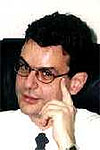Consider crime. Anarchists of all stripes agree that people have the right to exercise self-defense by organizing voluntarily to suppress malfeasance and put away criminals. Yet, is this not the very quiddity of the oppressive state, its laws, police, prisons, and army? Are the origins of the coercive state and its justification not firmly rooted in the need to confront evil?
Some anarchists believe in changing society through violence. Are these anarcho-terrorists criminals or freedom fighters? If they are opposed by voluntary grassroots (vigilante) organizations in the best of anarchist tradition - should they fight back and thus frustrate the authentic will of the people whose welfare they claim to be seeking?
Anarchism is a chicken and egg proposition. It is predicated on people's well-developed sense of responsibility and grounded in their "natural morality". Yet, all anarchists admit that these endowments are decimated by millennia of statal repression. Life in anarchism is, therefore, aimed at restoring the very preconditions to life in anarchism. Anarchism seeks to restore its constituents' ethical constitution - without which there can be no anarchism in the first place. This self-defeating bootstrapping leads to convoluted and half-baked transitory phases between the nation-state and pure anarchism (hence anarcho-syndicalism and some forms of proto-Communism).
Indeed, the term anarchism has been trivialized and debauched. Animal rights activists, environmentalists, feminists, peasant revolutionaries, and techno-punk performers all claim to be anarchists with equal conviction and equal falsity.
III. Reclaiming Anarchism
Errico Malatesta and Voltairine de Cleyre distilled the essence of anarchism to encompass all the philosophies that oppose the state and abhor capitalism ("anarchism without adjectives"). At a deeper level, anarchism wishes to identify and rectify social asymmetries. The state, men, and the rich - are, respectively, more powerful than the individuals, women, and the poor. These are three inequalities out of many. It is the task of anarchism to fight against them.
This can be done in either of two ways:
1. By violently dismantling existing structures and institutions and replacing them with voluntary, self-regulating organizations of free individuals. The Zapatistas movement in Mexico is an attempt to do just that.
2. Or, by creating voluntary, self-regulating organizations of free individuals whose functions parallel those of established hierarchies and institutions ("dual power"). Gradually, the former will replace the latter. The evolution of certain non-government organizations follows this path.
Whichever strategy is adopted, it is essential to first identify those asymmetries that underlie all others ("primary asymmetries" vs. "secondary asymmetries"). Most anarchists point at the state and at the ownership of property as the primary asymmetries. The state is an asymmetrical transfer of power from the individual to a coercive and unjust social hyperstructure. Property represents the disproportionate accumulation of wealth by certain individuals. Crime is merely the natural reaction to these glaring injustices.
But the state and property are secondary asymmetries, not primary ones. There have been periods in human history and there have been cultures devoid of either or both. The primary asymmetry seems to be natural: some people are born more clever and stronger than others. The game is skewed in their favor not because of some sinister conspiracy but because they merit it (meritocracy is the foundation stone of capitalism), or because they can force themselves, their wishes, and their priorities and preferences on others, or because their adherents and followers believe that rewarding their leaders will maximize their own welfare (aggression and self-interest are the cornerstone of all social organizations).
It is this primary asymmetry that anarchism must address.
First published here:
http://samvak.tripod.com/guide.html
(Note: You can view every article as one long page if you sign up as an Advocate Member, or higher).




